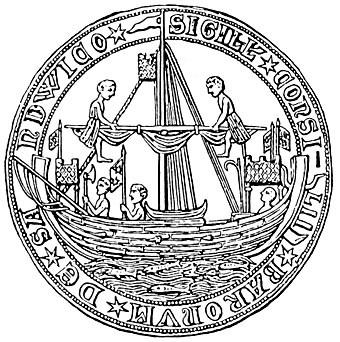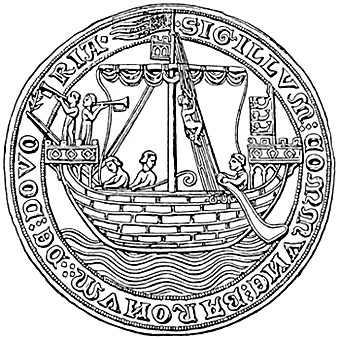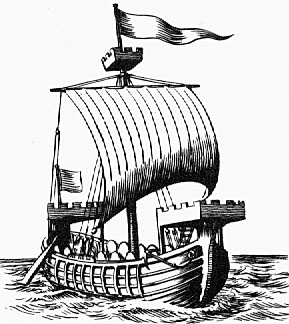It is hard to say precisely what many of the medieval ship types looked like. We rely mainly on contemporary depictions and, to a lesser extent, sculptural representations, supplemented by a few textual descriptions and scarce archaeological evidence. Merchant vessels have been excavated at Newport and at Sandwich; the latter, partially cannibalized, proved to be quite similar to the ship image on the town seals shown below: a clinker-built hulk 20-30 m. long, with cog-style stern form, median rudder, partial deck structure, single mainmast, and raised platforms at either end, probably built locally towards the close of the fourteenth century.
Artists' depictions of ships can be found in chronicles, but many of these medieval illustrations are untrustworthy. They may represent generalized or stylized interpretations by artists not very familiar with ship details. Or they may depict ships contemporary with the artist, but not with the time being written about. In some cases, the portrayal of the subject has been adapted to the limitations of the medium; carvings, for example, tend to be less detailed than paintings.
A number of communal seals of English towns incorporate depictions of ships. This is particularly true of Cinque Ports such as Dover, Sandwich, Pevensey, and Winchelsea, whose seals commemorate the association between privileges granted by the monarchy and naval service they gave kings upon demand. Civic seals only start appearing in any numbers in the thirteenth century, however, and their depictions have been constrained to fit a seal's confined space and shape.

The seal of Sandwich (1238) shows a style of ship
that appears to have derived from the knarr, which would be appropriate for
the centuries immediately following the service contract with the king.
Castles are shown at either end of the ship, as well as a smaller one at or near
the top of the mast, and a ship's boat can be seen at deck level. Figures carrying
banner and axe, as well as banners above the castles, indicate that the intent was
to depict a warship, although the ship may well have been a merchant vessel converted
to military use by addition of the castles. To fit the inner area of the seal,
the yard-arm has been shown lower than would have been the case.

The seal of Dover (1284). Its main castles are larger than
those in the Sandwich portrayal, and extend over the sides of the ship; a steering oar
is conspicuous near what ought to be the stern.
Nonetheless, sufficient detail is often given to allow historians to trace the general development of ship types and to reveal changes in ship design. For instance, the Cinque Ports' seals show variations on a general ship type, while a twelfth century representation of a hulk on the font in Winchester cathedral is the earliest known illustration of a stern rudder having superseded the long ship's steering oar.
In terms of the archaeology of medieval ships, the Gokstad ship is the best preserved example of a Viking long ship. A hull found at Bremen has provided important evidence of cogs. The remains of the huge Gracedieu, a purpose-built, cannon-equipped warship, have been found in the River Hamble; built at Southampton (1416-19) it represents the final design phase of the cog, influenced by the carrack. Henry V's military success in France precluded the Gracedieu seeing much service; it was laid up in a protected berth in the Hamble, where it deteriorated, burned after a lightning strike, and was left a wreck.
In 2002 an important discovery was made, at Newport, of a large and very well preserved ship built in the mid-fifteenth century, probably in France. Perhaps captured by English forces, or trading in Welsh waters, damage led to it ending up berthed in the River Usk for repairs, and it was apparently abandoned there. Still undergoing study and restoration, the Newport Ship is expected to throw new light on the bybridisation of northern and southern ship types in the fifteenth century. Built as a merchantman, it may also have seen naval service (or was at least prepared to defend itself), for among the excavation finds were stone cannon-balls, an archer's wrist-guard, and pieces of one or more metal helmets.

Artist's reconstruction of a warship of
the twelfth or thirteenth century, based on information from
sources such as the seals above.